

Balmain's Designer Explains Why He Loves When Brands Like Zara Copy Him. When Balmain's creative director, Olivier Rousteing, walks past a Zara window display and sees copies of his own designs, he doesn't get mad.

He feels flattered. "I think it was Coco Chanel who said if you're original, be ready to be copied," he told The Independent. "I'm really happy that Balmain is copied. " The designer (and Kim Kardashian's bestie) isn't just happy when major chains lift ideas from his runway shows and then mass produce them…he's actually complimenting them on a job well done! "I love seeing a Zara window with my clothes mixed with Céline and Proenza! Céline's designer Phoebe Philo shared a similar sentiment to Rousteing back in March when she was interviewed by British Vogue's editor-in-chief Alexandra Shulman as a part of the Vogue Festival. HMMM... ZARA SHAMELESSLY COPY EVERY MAJOR FASHION PLAYER - Fashion Editor at Large. I’m not a lawyer, but if I was a lawyer at LVMH I’d be getting busy with a suit against Zara on behalf of Christian Dior, Balenciaga, Celine and Kenzo.
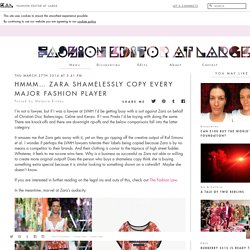
If I was Prada I’d be toying with doing the same. There are knock-offs and there are downright rip-offs and the below comparisons fall into the latter category. It amazes me that Zara gets away with it, yet on they go ripping off the creative output of Raf Simons et al. I wonder if perhaps the LVMH lawyers tolerate their labels being copied because Zara is by no means a competitor to their brands. And their clothing is caviar to the tapioca of high street fodder. If you are interested in further reading on the legal ins and outs of this, check out The Fashion Law. In the meantime, marvel at Zara’s audacity. Fashion Copycats. Zara faces BOYCOTT after being accused of 'stealing' designs from more than 20 artists. Retailer Zara has been accused of copying the designs of more than 20 independent artists in a new movement which calls for customers to boycott the store.
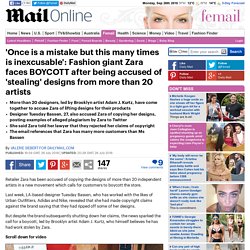
Last week, LA-based designer Tuesday Bassen, who has worked with the likes of Urban Outfitters, Adidas and Nike, revealed that she had made copyright claims against the brand saying that they had ripped off some of her designs. But despite the brand subsequently shutting down her claims, the news sparked the call for a boycott, led by Brooklyn artist Adam J. Kurtz, who himself believes he has had work stolen by Zara. Scroll down for video Standing up: A group of independent artists, led by Brooklyn designer Adam J. Pretty close: Adam noticed that the designs on some of Zara's recent badges (inset) look remarkably like his own creations Plenty to recognize: Adam banded together with more than 20 other artists who have also found very similar designs to their own on a range of Zara products 'Once is a mistake.
Loaded: 0% Progress: 0% Fashion brand Zara accused of copying LA artist's designs. The fast-fashion brand Zara is facing criticism for allegedly copying the designs of Tuesday Bassen, an independent artist based in Los Angeles.
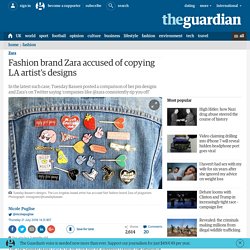
Bassen, an illustrator and designer, posted a side-by-side comparison of her pin designs next to Zara’s. “You know what? Sometimes it sucks to be an artist because companies like @zara consistently rip you off and deny it,” she wrote on Twitter on Tuesday night. Bassen has worked with Playboy, the New Yorker, the United Nations, Nike, Adidas and others, according to her website. This was her first interaction with Zara, she said in an email to the Guardian. Bassen said she first found out about the similarities from her fans, who amount to more than 100,000 followers on Instagram. The artist contacted Zara with a lawyer about the supposed copies. Bassen is not the only artist whose work has seemingly been lifted by Zara. Can fashion week designs REALLY work off the runway? While many people dismiss fashion month as nothing more than ridiculous, a lot of what the designers showcased on the runway will actually be filling our wardrobes in months to come.

With the more wearable trends - such as Burberry's chic lace and Topshop Unique's Eighties-inspired looks - comes the downright bizarre, like Maison Martin Margiela's glitzy offering and Kanye West's all-nude uniform that's been likened to Star Wars costumes. FEMAIL wanted to find out if the weird and wonderful trends to emerge from the style event can really work in real life - on a real woman - or whether they're better left on the catwalk.
Scroll down for video Breaking Phoebe Jackson-Edwards, left and right, in gently, we sent her onto the streets in a replica of one of Burberry's spring/summer 16 catwalk looks, centre, which garnered a lot of attention from the public. Counterfeit Street: Sunday Mirror investigates hidden 'shopping mall' of fake designer and electrical goods. Click to playTap to play Loaded: 0% Progress: 0% The Live Event you are trying to watch is either unavailable or has not started Please refresh this page in your browser to reload this live event video The shutters are down and the windows boarded up on the once-bustling high street.
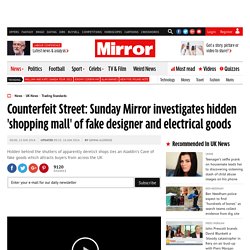
The derelict shops in the shadow of Strangeways Prison, Manchester, give all the appearance of being completely abandoned, sad and crumbling casualties of the economic crisis. But behind the locked doors of Bury New Road, in a maze of back alleys and basements, a new trade is flourishing – fake designer goods worth millions of pounds change hands here every year. It’s a hidden shopping mall and cash-and-carry all rolled into one, a secret outlet village where rogue traders buy fake supplies in bulk and sell them on across the country. The Government last week announced plans to crack down on the selling of fake goods, especially on the internet.
And we weren’t alone. Sunday Mirror These men are the spotters. ZARA Rips Off Kanye's YEEZY Season With New Collection. Fast-fashion retailer ZARA has pulled off the not-unimpressive feat of knocking off Kanye West’s YEEZY Season 2 collection before ‘Ye’s offerings even hits stores.

Kanye’s disheveled, oversized, dusty-hued streetwear has been replicated in all its glory in the “Streetwise” collection, via short-sleeved sweats, moth-chewed sweaters and minimalist luggage. Fast-fashion retailers’ vertically-integrated supply chains mean that they can churn out products in as little as two weeks, and are one of the reasons many luxury houses are contemplating moving to a “see now, buy now” model, rather than the traditional fashion calendar where goods aren’t available until six months after they’ve first been shown. You can shop the collection now over at ZARA’s web store, at a fraction of the price of the real deal. How the high street gets away with fashion robbery.
While the luxury fashion industry has been struggling to post any significant amount of revenue growth for some time now, fast-fashion retailers are thriving.
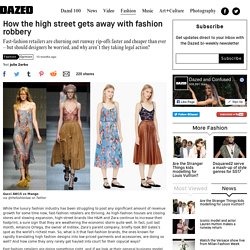
As high-fashion houses are closing stores and slowing expansion, high-street brands like H&M and Zara continue to increase their footprint, a sure sign that they are weathering the economic storm quite well. In fact, just last month, Amancio Ortega, the owner of Inditex, Zara’s parent company, briefly took Bill Gates’s spot as the world’s richest man. So, what is it that fast-fashion brands, the ones known for rapidly translating high fashion designs into low-priced garments and accessories, are doing so well? And how come they only rarely get hauled into court for their copycat ways? Fast fashion retailers are doing something right, and if we look at their general business model (and forget the negative side effects, like exploitative labour), it is innovative. High fashion to high street: how social media closed the gap between designer and consumer.